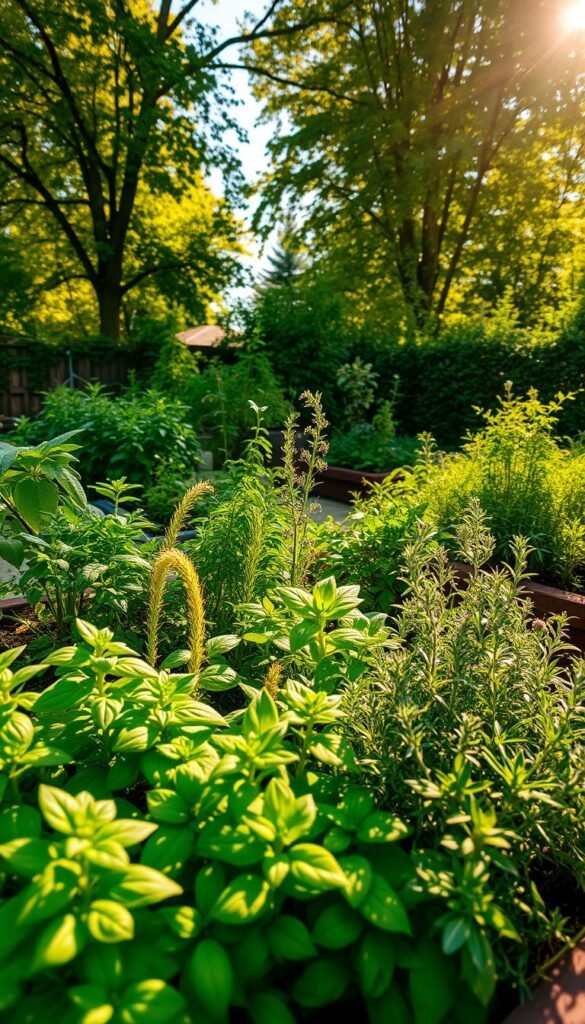Imagine stepping outside to snip fragrant basil or mint for tonight’s dinner. A small corner of your outdoor space can become a vibrant source of flavor and fragrance. Whether you’re working with a sprawling lawn or a compact patio, growing herbs offers endless possibilities.
These plants are surprisingly low-maintenance, thriving in everything from pots to raised beds. Many varieties adapt to sun or partial shade, making them ideal for tricky spots. You’ll enjoy fresh ingredients while adding natural charm to your home.
Herb gardening works for everyone. First-timers appreciate how forgiving these plants are, while seasoned growers love experimenting with unique varieties. Even a windowsill setup can yield enough oregano or thyme to upgrade your meals.
Beyond practicality, these green spaces create visual interest. Rosemary’s silvery foliage and lavender’s purple spikes turn functional plantings into eye-catching features. Your garden becomes a living pantry that looks as good as it tastes.
Ready to transform unused space into something delicious? Let’s explore how to design, plant, and maintain herbs that keep your kitchen stocked and your yard lively through every season.
Benefits of Growing Fresh Herbs at Home
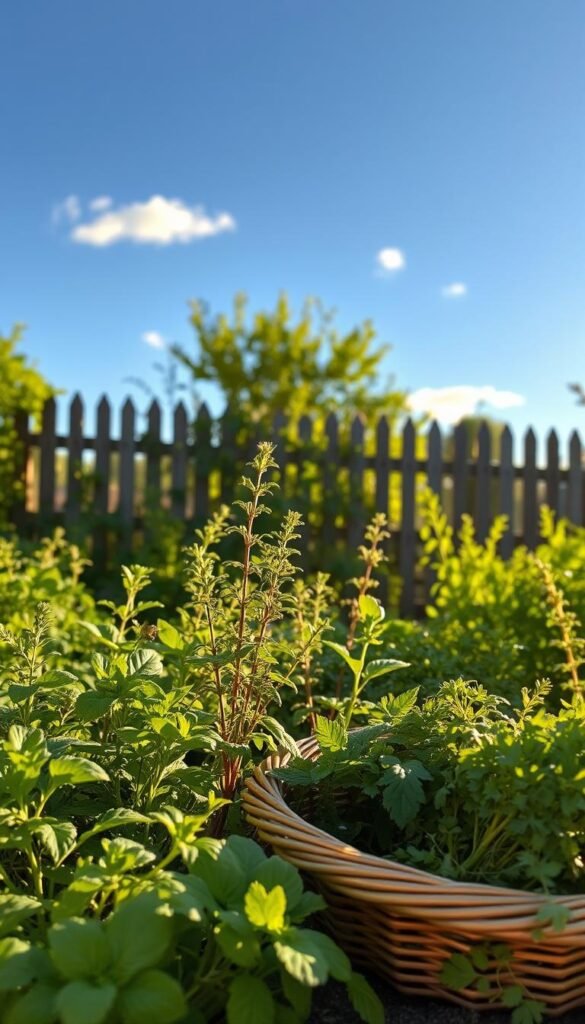
Turning your patio or balcony into a green oasis does more than beautify your space—it puts fresh herbs at your fingertips daily. These plants act like nature’s multitaskers, blending practicality with natural charm.
Enhancing Your Outdoor Space
Herbs like lavender and rosemary add texture and color to any setup. Their scents naturally repel mosquitoes while attracting butterflies, creating a lively ecosystem.
Most varieties thrive in containers, making them perfect for small areas. You’ll save money too—a $3 basil plant yields months of fresh leaves, unlike store-bought packs that wilt fast. For beginners, no-fail herbs to grow in containers simplify the process.
Year-Round Flavor and Health Advantages
Nothing beats the punch of flavor from just-picked mint or thyme. Dried herbs lose potency, but homegrown ones keep their zing. Many also offer health perks—sage supports immunity, while oregano packs antioxidants.
With a variety that grows indoors or out, you’ll always have ingredients ready. Snip what you need, and plants bounce back fuller. It’s a sustainable cycle that cuts plastic waste and keeps meals exciting.
Assessing Your Space and Light Requirements
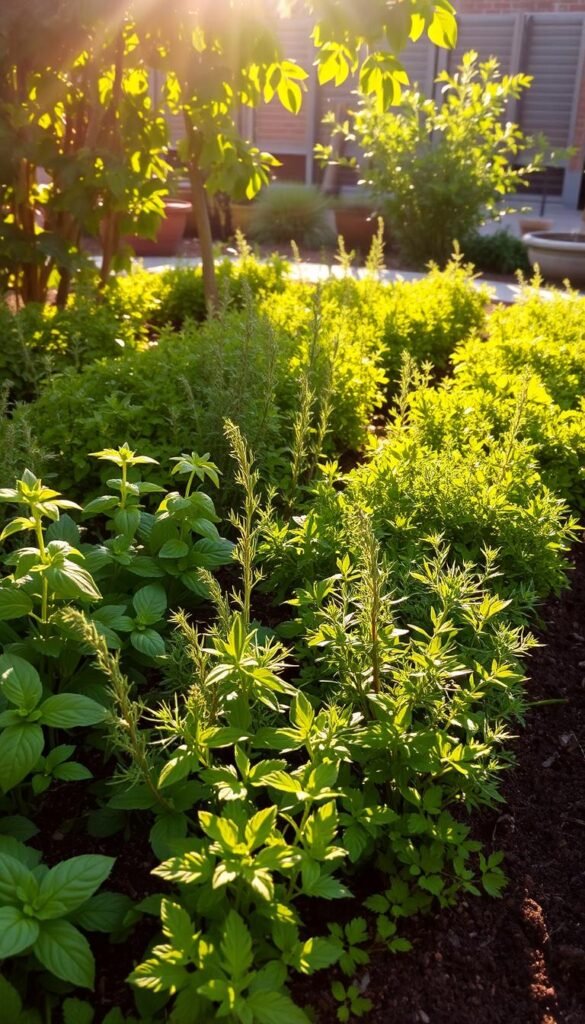
Light and space determine how well your herbs will thrive. Start by watching how sunlight moves across your garden throughout the day. Use a notebook to mark areas getting 6+ hours of direct sunlight versus spots with 3-4 hours of dappled light.
Matching Plants to Your Conditions
Basil and rosemary love full sun, while mint and cilantro thrive in partial shade. Hot climates? Give leafy herbs afternoon shade to prevent wilting. Cooler regions? Maximize southern exposures for warmth-loving varieties.
Keep your garden near walkways or windows you frequent. You’ll remember to water parsley by the back door and grab thyme quickly during meal prep. Visibility matters—brown leaves or dry soil catch your eye faster when plants are in daily view.
| Herb | Sun Needs | Best Location |
|---|---|---|
| Basil | Full sun (6+ hours) | South-facing beds |
| Mint | Partial shade (3-4 hours) | Under trees/near walls |
| Cilantro | Morning sun only | East-facing containers |
Notice how buildings or fences create partial shade zones? These microclimates help delicate herbs survive summer heat. Track seasonal changes too—a sunny spring spot might become shaded when trees leaf out.
Soil, Containers, and Raised Bed Options
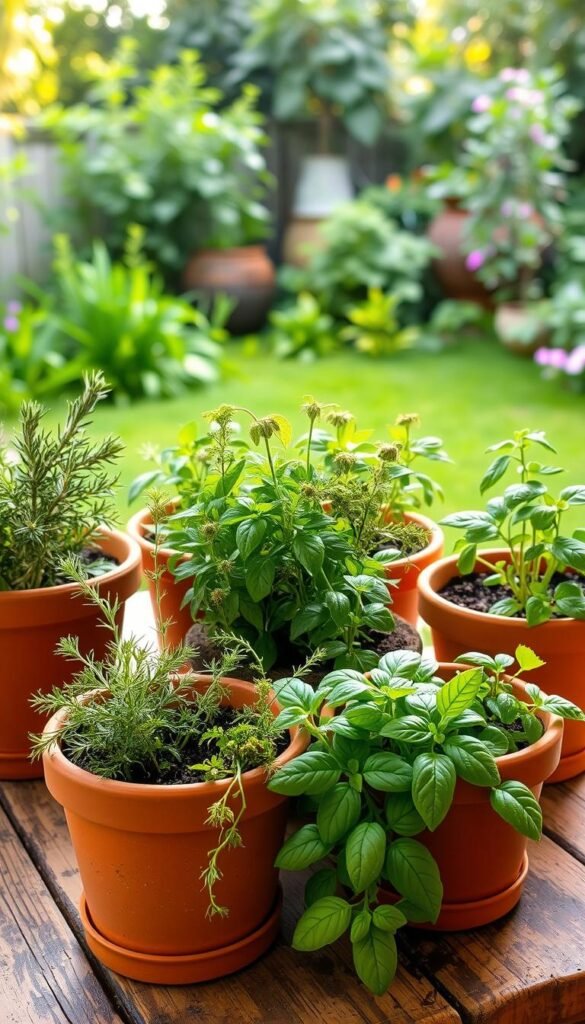
The foundation of a thriving herb garden starts beneath the surface. If your yard has rich, crumbly soil that drains quickly after rain, planting directly in the ground works well. For heavy clay or sandy soils, raised garden beds let you control the growing environment. Fill them with a mix of compost and well-drained soil for roots that stay healthy.
Garden containers shine in small spaces like patios or balcony gardens. Choose pots with multiple drainage holes—terracotta breathes better than plastic, while wooden boxes add rustic charm. Shallow-rooted thyme thrives in 6-inch-deep pots, but rosemary needs 12 inches to stretch.
| Container Type | Best For | Drainage Tip |
|---|---|---|
| Terra Cotta | Mediterranean herbs | Add gravel layer |
| Plastic | Moisture-loving mint | Drill extra holes |
| Fabric Bags | Deep-rooted varieties | Elevate off ground |
Raised beds solve two problems at once: poor native soil and back strain. Build them 12-18 inches tall for easy access. Mix 60% topsoil with 30% compost and 10% sand for ideal texture. This blend prevents waterlogging while keeping herbs nourished.
Remember: container plants need potting mix, not garden soil. Bagged mixes resist compaction and provide steady nutrients. Check moisture daily—potted herbs dry out faster than those in beds.
Step-by-Step Guide to Planting Your Herb Garden
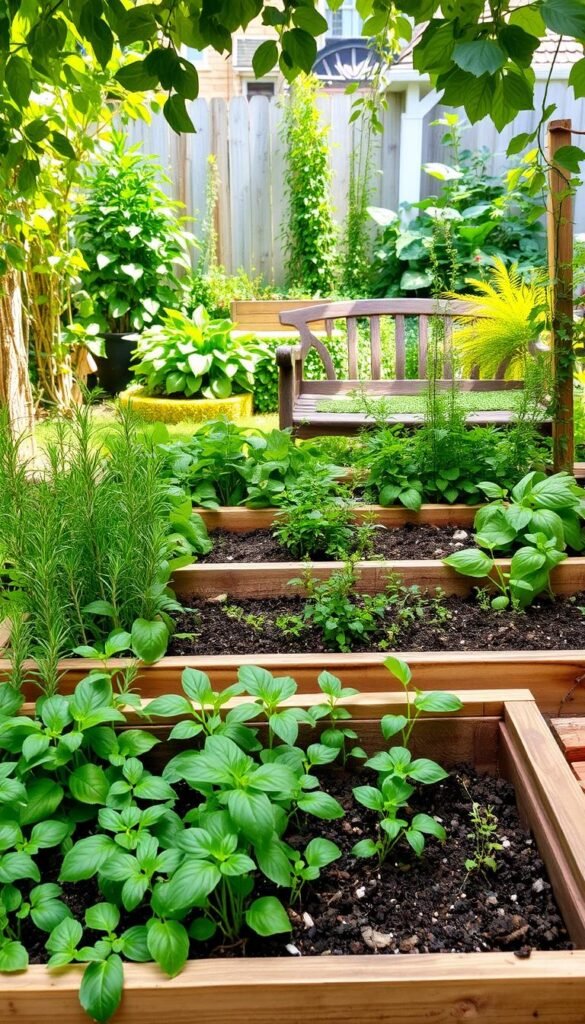
Planting your own herbs transforms empty pots into flavor factories. Let’s break down the essentials for setting up plants that thrive. With smart prep and simple techniques, you’ll create a productive space in no time.
Preparing Containers and Well-Drained Soil
Start by choosing containers matching your herbs’ needs. Check plant tags for spacing tips—parsley needs 8 inches between plants, while oregano spreads wider. Mix two parts potting soil with one part perlite for well-drained soil that prevents soggy roots.
| Container Type | Best Match | Pro Tip |
|---|---|---|
| Clay Pots | Rosemary, thyme | Water less frequently |
| Plastic Boxes | Basil, cilantro | Add drainage holes |
| Fabric Planters | Mint family | Isolate aggressive growers |
Planting Techniques for Healthy Growth
Set each herb at its original growing depth—burying stems invites rot. Water gently after planting to settle the soil. Space seedlings based on their mature size, even if pots look bare initially.
Mint needs special handling. Confine it to solo containers or it’ll crowd neighbors. For timed success, plant cold-hardy chives in early spring but wait until May for heat-loving basil.
Check moisture daily for the first week. Roots establish faster when soil stays slightly damp. Within weeks, you’ll see new growth—your garden is ready to flavor meals!
Selecting the Ideal Herbs for Your Culinary Needs
Your favorite recipes deserve fresh ingredients right from the garden. Start by matching herbs to your cooking habits—whether you’re making pesto weekly or infusing oils occasionally. Popular picks like basil, cilantro, and parsley offer instant kitchen upgrades, while medicinal varieties serve dual purposes.
Flavor First or Multipurpose Plants?
Focus on herbs you’ll actually use. Italian cooks might prioritize oregano and rosemary, while taco lovers need cilantro on demand. “Grow what you’ll reach for daily—it’s easier to maintain plants you value,” suggests a seasoned gardener. Medicinal types like lemon balm work for tea but may crowd limited spaces.
Seed Starting vs Ready-to-Plant Options
Some herbs sprout quickly from seeds. Cilantro and basil thrive when sown directly into soil after frost. Others, like thyme and sage, grow faster from starter plants. Avoid big-box store purchases—their herbs often arrive stressed. Local nurseries provide healthier options adapted to your climate.
| Herb | Best Start Method | Pro Tip |
|---|---|---|
| Basil | Seed | Direct sow after frost |
| Rosemary | Starter Plant | Buy from local growers |
| Cilantro | Seed | Plant every 3 weeks |
| Mint | Starter Plant | Use separate containers |
Plan for space and seasons. Cool-weather herbs like parsley extend harvests, while basil loves summer heat. Compact varieties fit small plots, but give mint room to roam. Your kitchen will thank you!
Caring for Your Herb Garden Throughout the Seasons
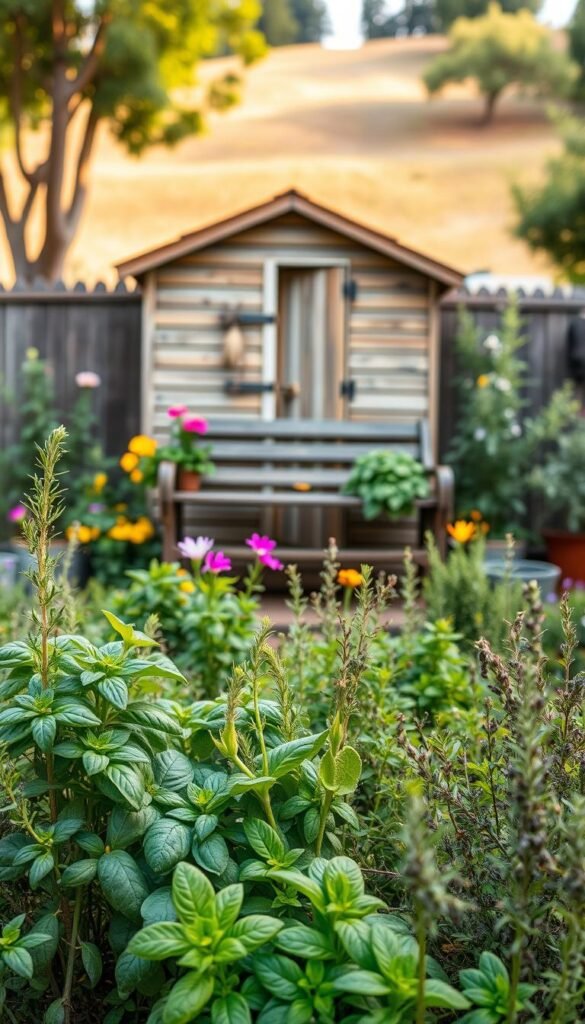
Seasonal shifts demand tailored attention to keep your herbs thriving. Like adjusting a recipe, your care routine should evolve as temperatures change. Start by observing growth patterns—lush spring leaves often slow in summer heat.
Watch for curled leaves or faded color—these signal stress from too much sun or water. Mint turns leggy without enough light, while basil drops leaves when cold. Quick fixes prevent bigger issues: move pots, adjust shade cloths, or improve drainage.
| Season | Key Tasks | Herbs Affected |
|---|---|---|
| Spring | Divide perennials, fertilize | Chives, oregano |
| Summer | Harvest often, water deeply | Basil, cilantro |
| Fall | Trim woody stems, mulch | Rosemary, sage |
| Winter | Protect roots, reduce watering | Thyme, parsley |
Prepare tender plants for frost by moving potted herbs indoors or covering garden beds with burlap. A kitchen herb garden extends harvests through colder months. Rotate crops annually to prevent soil fatigue.
Time your pruning—cut back aggressive growers like lemon balm in early fall. Water morning-only during heat waves to prevent mildew. With smart seasonal shifts, your garden becomes a year-round flavor source.
Watering and Fertilizing for Optimal Growth
Keeping herbs happy comes down to two essentials: hydration and nutrition. Check soil moisture daily—press your finger into the top inch. If it feels dry, give your plants a deep drink. Containers dry faster than garden beds, especially in summer heat.
Water thoroughly but avoid soggy roots. Let the liquid soak through drainage holes, then wait until the next check. For garden beds, morning watering reduces evaporation. Potted herbs might need afternoon sips during heatwaves.
Feed every 7-14 days with balanced liquid fertilizer. Half-strength doses work best—too much can burn delicate roots. “Think of it like vitamins, not meals,” says a master gardener. Skip feeding in winter when growth slows.
| Issue | Signs | Fix |
|---|---|---|
| Overwatering | Yellow leaves | Let soil dry |
| Underwatering | Crispy edges | Soak pot fully |
| Nutrient Lack | Slow growth | Boost feeding |
For large setups, drip lines save time and water. Adjust routines seasonally—cut back in cool months. With smart hydration and feeding, your plants stay lush from spring frost to fall harvest.
Managing Pests and Promoting Air Circulation
Healthy herbs need smart protection and breathing room. A few simple habits keep plants strong while reducing unwanted visitors. Let’s explore how to balance moisture and airflow for thriving growth.
Natural Pest Control and Excess Water Management
Overwatering invites trouble. Soggy soil attracts fungus gnats and encourages root rot. Check moisture levels before watering—let the top inch dry out first. For persistent pests, spray leaves with diluted neem oil or a mix of castile soap and water.
Companion planting adds defense. Marigolds deter aphids, while basil repels flies near tomatoes. Pairing herbs with these allies creates natural barriers. Drip irrigation systems minimize excess water waste, delivering hydration right to roots.
Discover more organic pest control strategies to protect your plants without harsh chemicals.
Ensuring Good Air Circulation and Well-Drained Soil
Space plants properly to prevent overcrowding. Prune dense foliage weekly to let good air flow between stems. This reduces mildew risk and strengthens stems against wind.
Use gritty potting mixes and containers with drainage holes. Elevate pots slightly to avoid standing water. For garden beds, mix in perlite or coarse sand to boost drainage. Air circulation improves when leaves stay dry and soil breathes freely.
With these steps, your green space stays vibrant and productive. Healthy herbs mean fewer headaches—and more time enjoying their flavors!

